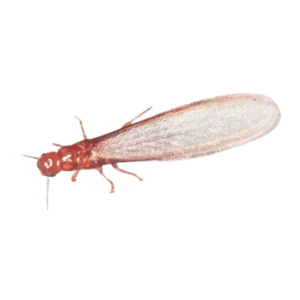
Drywood Termite

Drywood Termites: Thriving in Dry Climates with Unique Feeding Habits and Identification
Drywood Termites primarily inhabit warm and arid regions, which makes them well-suited to dry and dry-subtropical climates. They thrive in areas with minimal moisture, in contrast to their counterparts, the Subterranean Termites. People commonly discover these termites in wooden structures, especially in regions with a history of termite infestations.
Known for their distinct feeding habits, Drywood Termites primarily consume dry, sound wood, which sets them apart from Dampwood Termites that prefer damp and decaying wood. Their consumption of wooden structures can lead to extensive damage and structural issues in homes and buildings.
These insects are relatively small, measuring around half an inch to three-eighths of an inch in length. They have soft, pale-colored bodies with straight antennae. Unlike ants, termites possess a broad waist, and their wings are nearly equal in size. These features distinguish them from other winged insects, making identification easier.
Reproduction and Life Cycle Insights
The reproductive system of Drywood Termites follows a pattern similar to that of many other termite species. Colonies comprise kings and queens responsible for egg-laying, accompanied by workers and soldiers. Queens lay eggs, which hatch into nymphs. As these nymphs mature, they develop into various castes, including kings and queens that can initiate new colonies.
The life cycle of Drywood Termites includes egg, nymph, and adult stages. Queens can live for several years, while workers and soldiers have shorter lifespans. To maintain colony efficiency, termites continually replace aging individuals. The entire life cycle can span several years, contributing to the colony’s resilience.
Environmental and Health Implications
While Drywood Termites are more focused on consuming dry wood than performing other environmental functions, they have a relatively minimal impact on the environment compared to other termite species. However, when they infest wooden structures, they can cause deforestation, tree loss, and alterations in the ecosystem, indirectly affecting local wildlife and plant life.
Drywood Termites do not directly pose health risks to humans through bites or stings. However, their presence in homes can indicate structural issues that may lead to costly repairs. Additionally, mold and mildew growth associated with damp wood resulting from termite activity can have negative health effects on residents.
The Lesser Invasive Yet Troublesome Wood Destroyers
Drywood Termites are less invasive compared to Subterranean Termites, but they still pose a significant threat to wooden structures and property owners. Their preference for dry wood makes them particularly troublesome in regions prone to termite infestations.
These termites may infiltrate homes through cracks, crevices, or openings in wooden structures. They often find their way in during swarming seasons when winged termites are searching for new nesting sites. Wooden structures in regions prone to termite infestations are common targets.
Conclusion
Drywood Termites, although less invasive than their Subterranean counterparts, can still wreak havoc on wooden structures. Understanding their habits, habitat, and potential impact on human structures is essential for homeowners and property maintenance. In regions where Drywood Termites are prevalent, proactive measures and regular inspections can help protect properties from the damage these termites can cause.

